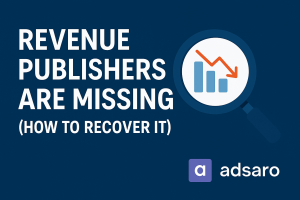In the fast-evolving digital advertising landscape, visibility and engagement are key drivers of ad performance. One of the most debated ad formats in recent years is the sticky ad, also known as a floating ad. These ads remain fixed in a specific position on the screen as users scroll through content, ensuring constant visibility. While sticky ads can enhance ad viewability and revenue, they also raise concerns about user experience, banner blindness, and compliance with ad policies.
But do sticky ads actually work? Should publishers and advertisers invest in them? This blog will explore the advantages and disadvantages of sticky ads, discuss best practices for implementation, and evaluate their overall effectiveness in digital advertising.
What Are Sticky Ads?
Sticky ads, or fixed-position ads, are a type of advertisement that remains visible on the screen as users scroll through a webpage. Unlike traditional static ads, which disappear when a user scrolls past them, sticky ad formats stay locked in place, ensuring higher exposure. These ads can be placed in different locations, including:
- Sticky Sidebar Ad: Positioned on the side of the page and remain visible while scrolling.
- Sticky Header Ad: Fixed at the top of the screen, staying visible as users browse.
- Sticky Footer Ad: Anchored at the bottom of the page, ensuring continuous visibility.
- Sticky In-Content Ad: Integrated within the content and remain visible while scrolling.
By keeping the ad constantly in view, sticky advertising helps advertisers gain more impressions, increasing engagement and potential conversions.
Pros
1. Higher Ad Viewability and Engagement
One of the primary benefits of sticky ads is their increased visibility. Since these ads remain on the screen, they achieve much higher viewability rates than standard display ads. This means:
- Users are more likely to notice and interact with sticky ads.
- Advertisers get better ad performance metrics, leading to higher demand and CPM rates.
- Publishers can attract premium advertisers willing to pay for highly visible ad slots.
2. Increased Ad Revenue
Sticky ads often generate higher ad revenue for publishers. Since they remain visible longer, advertisers see more value in these placements, leading to:
- Higher CPM (Cost Per Thousand Impressions) rates.
- Better fill rates, as sticky ads often perform better than standard banner ads.
- More effective monetization strategies, especially for high-traffic websites and mobile apps.
3. Better User Experience Compared to Pop-Ups
Unlike pop-up ads, which interrupt the user’s browsing experience, sticky ads are less intrusive. Because they remain fixed in one position, they don’t force users to interact with them. When placed correctly, sticky ads can be an effective way to display ads without disrupting user engagement.
4. Optimized for Mobile Advertising
With mobile usage continuing to grow, sticky mobile ad have become a powerful tool for mobile ad monetization. Sticky ads:
- Stay visible in limited screen space, increasing ad engagement.
- Do not interfere with content, unlike interstitial ads.
- Work well with mobile-first strategies to improve mobile ad revenue.
Cons
1. Potential for User Frustration
If sticky ads are not well-designed, they can become annoying for users, especially if they:
- Cover important content or obstruct navigation.
- Are too large and take up excessive screen space.
- Appear in areas where users expect to interact with the site.
2. Lower Engagement for Certain Placements
Although sticky banner ad stay on the screen longer, they may not always result in high engagement. Users often develop banner blindness, where they ignore ads placed in predictable locations, such as sidebars and footers.
3. Compliance with Ad Policies
Many advertising platforms, including Google AdSense, have strict policies regarding sticky ad. Non-compliance can result in:
- Reduced ad earnings.
- Ads being blocked or penalized.
- Limited demand from premium advertisers.
4. Can Affect Page Speed
Sticky ads often require additional JavaScript and CSS, which can slow down page loading speeds. If not optimized correctly, this can lead to:
- Poor user experience.
- Higher bounce rates.
- Negative impact on SEO rankings.
Best Practices for Implementing Sticky Ads
To maximize the benefits of sticky ad while minimizing drawbacks, follow these best practices:
- Ensure Ads Do Not Cover Content – Avoid placing ads where they obstruct essential information or user interactions.
- Use Proper Placement – Sticky sidebar ad and sticky footer ad are often less intrusive than header placements.
- Follow Ad Network Guidelines – Google AdSense and other networks have strict rules on sticky ad. Always check for compliance.
- Optimize for Mobile Devices – Ensure sticky mobile ad are responsive and do not negatively impact UX.
- Test Different Positions – Use A/B testing to determine which sticky ad placements perform best for your audience.
Do Sticky Ads Work?
Yes, sticky ads can be highly effective when implemented strategically. They offer benefits such as higher viewability, increased ad revenue, and mobile optimization. However, their success depends on careful placement, compliance with ad policies, and maintaining a positive user experience.
Publishers should always consider their audience’s preferences and test different sticky ad formats to find the right balance between monetization and user engagement.
Conclusion
Sticky ads are a double-edged sword in digital advertising. On one hand, they offer higher visibility, better engagement, and increased revenue opportunities. On the other, they can lead to user frustration, ad blindness, and compliance risks if not implemented properly.
To make the most of ads, publishers should:
- Follow best practices for placement and design.
- Ensure compliance with advertising network policies.
- Optimize for mobile and desktop experiences.
- Continuously test and refine sticky ad strategies to improve performance.
When used effectively, sticky advertising can be a game-changer for publishers looking to maximize their ad revenue and engagement without compromising user experience.








Leave a Reply